Sneideman's 7th Grade Life Science Blog
A collection of posts from a 7th grade science teacher. Enjoy.
Monday, October 21, 2013
Friday, July 19, 2013
David Attenborough - First LIfe - Series 2 - 1/4, 2/4, 3/4 and 4/4
This is the second set of videos that explains what happens after the Ediacaran and Vendian era and goes into the Cambrian explosion of life.
This is what we are podcasting on.
Your homework assignment is to take notes on these videos to help you with gather information for your podcasts.
After watching all 4 videos: leave your comment. Please read the comments of your peers and correct any mistatements - bonus point for corrections. Your comment should be a full paragraph and comment on your understanding of the Cambrian Explosion of Life.
1/4
2/4
3/4
4/4
This is what we are podcasting on.
Your homework assignment is to take notes on these videos to help you with gather information for your podcasts.
After watching all 4 videos: leave your comment. Please read the comments of your peers and correct any mistatements - bonus point for corrections. Your comment should be a full paragraph and comment on your understanding of the Cambrian Explosion of Life.
1/4
2/4
3/4
4/4
Present-day life forms are descended from past life forms; all life is related.
Do Now#____
What does this statement mean to you? Present-day life forms are descended from past life forms; all life is related.
TREE OF LIFE VIDEO - FROM YALE - CLICK HERE FOR VIDEO.
What does this statement mean to you? Present-day life forms are descended from past life forms; all life is related.
TREE OF LIFE VIDEO - FROM YALE - CLICK HERE FOR VIDEO.
DNA Unzipping - Do NOw 14
Do Now #14 - What happens to the DNA after it unzips and makes a copy of itself?
MEOSIS vs. MITOSIS

MEOSIS vs. MITOSIS

Eukaryotes:
How do we know that the eukaryote evolved before the evolution of plants, animals, protists and fungi?
Eukaryote Research
Endosymbiosis

Eukaryote Research
Endosymbiosis

Sunday, May 12, 2013
Saturday, April 6, 2013
Tarbut V'Torah: TVT Middle School Teacher Named 2013-14 Albert Einstein Distinguished Educator
Wednesday, May 30, 2012
Wednesday, May 16, 2012
Thursday, May 10, 2012
Wednesday, May 9, 2012
Test on Plants - Study Guide
Chapter 12
TEST ON PLANTS
What is a plant?
Seedless plants ?
Seed plants?
Structures of a flower
Structure of a seed?
Diagram the branching groups of plants and know examples?
Know the importance of the different groups?
Why are flowering plants more diverse?
What are stomata? (pg 378)
Be able to identify a plant as gymno or angio, monocot or dicot?
Understand the role of pollinators in the flowering plant?
How are non-flowering plants pollinated?
Review the section reviews and the worksheets that I handed out at the beginning of the unit.
What are the difference between monocot and dicots?
BE ABLE TO IDENTIFY PLANTS by general categories.
Sunday, May 6, 2012
flower anatomy quiz
Sepals



Image - NBII.Gov; Text correction Margaret Esaak, licensed to About.com.
- Anther: The anther is part of the stamen and produces the pollen.
- Articulation: Another term for articulation is internode. Articulation describes the space between two nodes (joints).
- Calyx: The whorl of sepals on the outside of a flower is referred to as the calyx.
- Corolla: The whorl of petals is called the corolla.
- Filament: The filament provides support for the anther in the stamen.
- Floral Axis: The floral axis is the stem holding the reproductive flower parts.
- Microsporangium: The microsprangium is located in the anther and produces microspores, which become male gametophytes. These male gametophytes will later be used in forming the pollen grains.
- Nectary: The nectary produces nectar, a sweet liquid that attracts insects and birds for feeding. As they drink the nectar, the nearby pollen sticks to them and is transported to other flowers.
- Ovary: The ovary houses the ovules and will become the fruit after pollination.
- Ovule: The ovules contain egg cells and become the seeds after pollination.
- Pedicel:The pedicel is the flower stalk.
- Perianth: The perianth is the collective term for the calyx and corolla.
- Petal: The petal is designed to attract pollinators to the flower and protect the stamen and pistil. Many have patterns that can be seen in ultraviolet light by bees and other insects. These indicate where the nectar is located.
- Pistil: The pistil is the female reproductive part in the flower. It includes the ovary, style, and stigma.
- Sepal: Sepals are found on the outside of the flower in a whorl. They are usually green. The group of sepals is called the calyx.
- Stamen: The stamen is the male reproductive organ in the plant. It consists of the anther and filament.
- Stigma: The stigma is the sticky surface where pollen lands and is collected to fertilize the ovules.
- Style: The style is part of the pistil and holds the stigma above the ovary.

monocot eudicot
Angiosperms, flowering plants, are divided into two groups:
monocots and dicots.


http://www.emc.maricopa.edu/faculty/farabee/biobk/biobookplantanatii.html
MONOCOT CROSS SECTION AND TRANSECTION
T.S. of a Monocot Root
Cross-Section of a Monocot Root
Interesting Fact =
Monocot seeds have one "seed leaf" termed a cotyledon (in fact monocot is a shortening of monocotyledon). Dicots have two cotyledons. Both groups, however, have the same basic architecture of nodes, internodes, etc.

Comparison of monocot (left, oat) and dicot (right, bean) gross anatomy


http://www.emc.maricopa.edu/faculty/farabee/biobk/biobookplantanatii.html
MONOCOT CROSS SECTION AND TRANSECTION
Interesting Fact =
Monocot seeds have one "seed leaf" termed a cotyledon (in fact monocot is a shortening of monocotyledon). Dicots have two cotyledons. Both groups, however, have the same basic architecture of nodes, internodes, etc.

Comparison of monocot (left, oat) and dicot (right, bean) gross anatomy
Monday, March 26, 2012
Study Guide Chapter 6
Study guide for Chapter 6 Test
Vocabulary
Heredity
Dominant trait
Recessive trait
Gene
Allele
Phenotype
Genotype
Probability
Punnett Square
Heterozygous
Homozygous
True Breeding
Genetic variation
Gene pool
What is the difference between a trait and a characteristic
What is the difference between a gene and allele
What is the difference between genotype and phenotype
What is the difference between true breeding and not true breeding?
Know how to fill in a Punnett square and then calculate percentages
What happened after Mendel’s 1st generation and 2nd generation?
What is sickle cell anemia? What does it tell us about genes?
How are genes and alleles related to genotype and phenotype?
1 R R R r | 2 T t t t |
3 s S s S | 4 t T T t |
In square 1 what is the possibility of having a RR, Rr and rr, genotype offspring?
RR_____ Rr ______ rr_______
In square2 what is the possibility of having a TT, Tt and tt, genotype offspring?
TT_____ tT ______ tt_______
Make your own Punnett Square.
If mom is heterozygous purple skin and dad is homozygous orange skin what are the chances the baby has purple or orange skin? P = purple - p = orange.
Monday, February 20, 2012
Mini Lab: Our Brain's Ability to Ignore Adaptation
7th grade
image and its negative afterimage each form distinct and meaningful percepts.
Mini labs
IN lab notebooks:
1. Title
2. Background notes/ Observations
3. Problem/question:
4. Hypothesis
5. Record data – either in a data table or general observations
6. Include a Data table when necessary
7. Include a graph when necessary
8. Conclusions
9. Questions to consider
Title:
Adaptations: Our brain's ability to ignore unnecessary information
Read the following passage Qucikly. Count the number of (Fs) that you see.
FINISHED FILES ARE THE RE-
SULT OF YEAR OF SCIENTIF-
IC STUDY COMBINED WITH THE
EXPERIENCE OF MANY YEARS
OF EXPERTS
I cnduo't bvleiee taht I culod aulaclty uesdtannrd waht I was rdnaieg. Unisg the icndeblire pweor of the hmuan mnid, aocdcrnig to rseecrah at Cmabrigde Uinervtisy, it dseno't mttaer in waht oderr the lterets in a wrod are, the olny irpoamtnt tihng is taht the frsit and lsat ltteer be in the rhgit pclae. The rset can be a taotl mses and you can sitll raed it whoutit a pboerlm. Tihs is bucseae the huamn mnid deos not raed ervey ltteer by istlef, but the wrod as a wlohe. Aaznmig, huh? Yaeh and I awlyas tghhuot slelinpg was ipmorantt! See if yuor fdreins can raed tihs too.
Introduction
Termites use trail pheromones to mark a trail which is followed by others. Each individual deposits a small amount of pheromone from a gland onto the surface. The insects also follow certain other chemicals. This effect can be used to show the characteristic trail-following adaptive behavior of the termites.
positive
In biology, `adaptation' refers to the gradual process by which a species becomes
better suited to its environment. For example, humans and monkeys evolved from a
common primate ancestor (Darwin 1859). Psychologists use the term adaptation to refer
to rapid changes in perceptual sensitivity, including the brain's adjustment to brightness
that gives rise to the negative afterimage in the illusion (Clifford and Rhodes 2005).
So, in both senses of the word, our commemorative Darwin Illusion shows adaptation
in action. Basing the illusion around an afterimage also seemed especially appropriate,
given the interests of Charles Darwin's immediate forebears: his father (Robert Darwin)
and grandfather (Erasmus Darwin) both carried out pioneering research into this curious
optical phenomenon (Wade 2002).
The illusion combines two visual effects. First, staring at the picture produces
a negative afterimage, in which the black-and-white pattern is reversed. Second, the
`resolution' of the afterimage is lower than that of the actual image, and so the thin
white lines vanish, making it impossible to see the monkeys (see Harmon and Julesz
1973). To our knowledge, the Darwin Illusion is the first demonstration in which the
Thursday, February 9, 2012
Lines of Evidence for Evolution

1. Homologous Structures!
2. Vestigial Structures!
3. DNA Analysis!
4. Embryological Similarities!
5. Fossil Evidence (Transitional Animals)!
Homologous Structure:








Vestigial Structure



3. DNA -

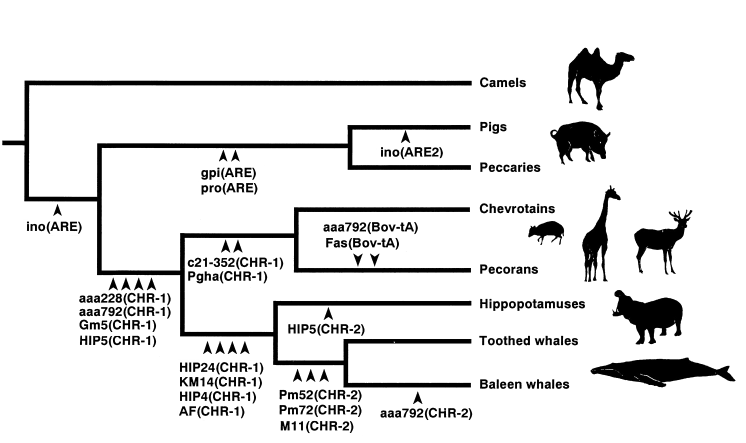

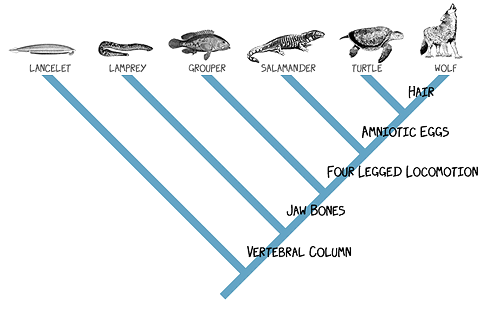

- Chimpanzees are 96% to 98% similar to humans, depending on how it is calculated. (source)
- Cats have 90% of homologous genes with humans, 82% with dogs, 80% with cows, 79% with chimpanzees, 69% with rats and 67% with mice. (source)
- Cows (Bos taurus) are 80% genetically similar to humans (source)
- 75% of mouse genes have equivalents in humans (source), 90% of the mouse genome could be lined up with a region on the human genome (source) 99% of mouse genes turn out to have analogues in humans (source)
- The fruit fly (Drosophila) shares about 60% of its DNA with humans (source).
- About 60% of chicken genes correspond to a similar human gene. (source)
The number of genes across a few tested species can be compared on HomoloGene.
4. EMBRYOLOGICAL SIMILARITIES

4.
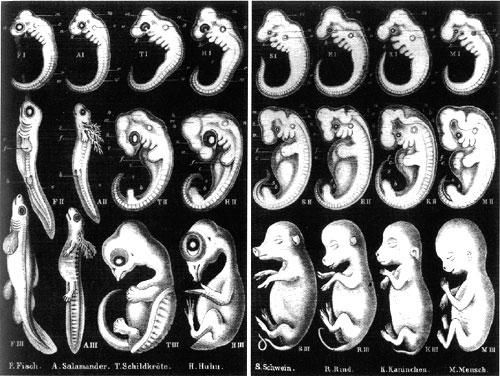
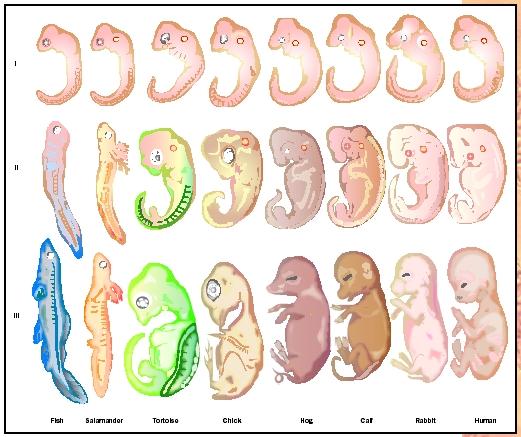
5.Fossil Record


 Download this graphic from the Image library. |

http://chem.tufts.edu/science/evolution/horse_series_icon.gif
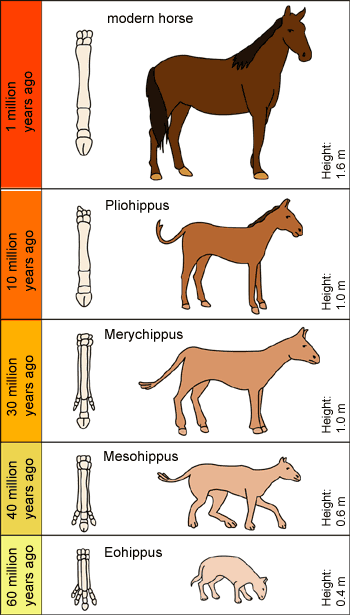
Tuesday, February 7, 2012
Friday, February 3, 2012
Geologic Firsts
http://instruct.westvalley.edu/svensson/b41LifeonEarth.html
http://evolution.berkeley.edu/evosite/evohome.html
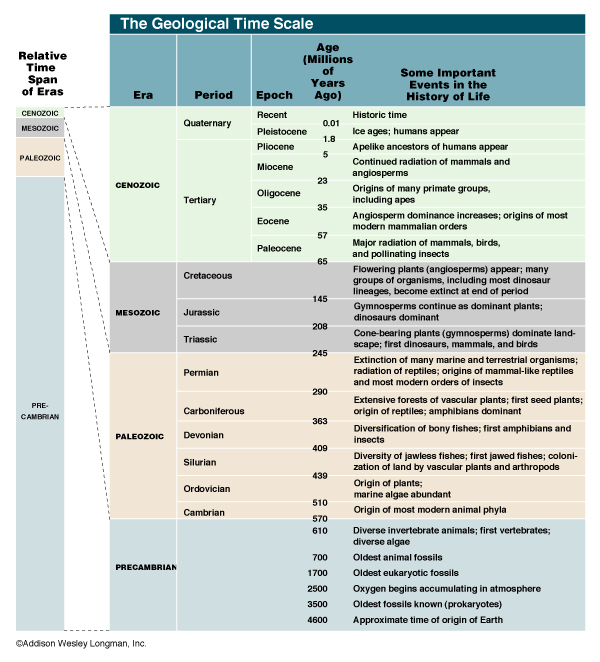
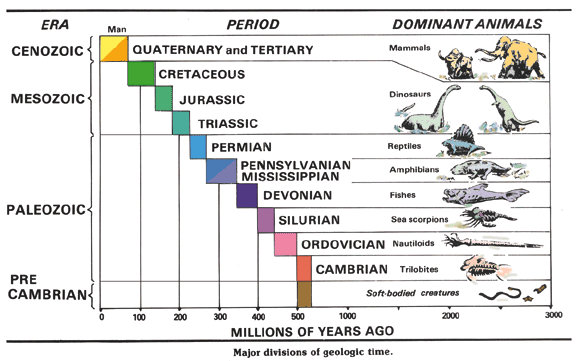
Three main types of subdivisions of geologic time
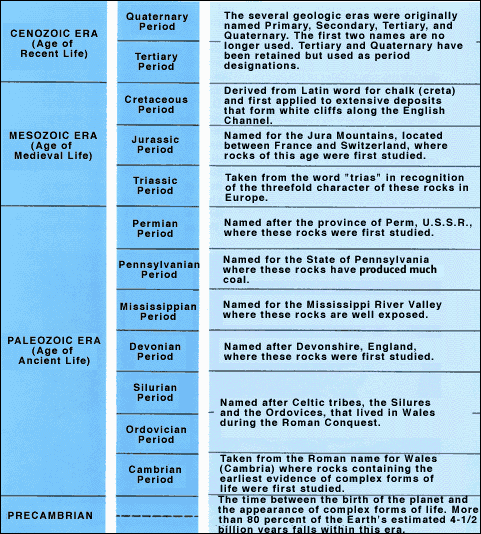


http://evolution.berkeley.edu/evosite/evohome.html


Three main types of subdivisions of geologic time
Eras:
Are major subdivisions of the geologic time scale and are based on differences of life forms.
Periods: Based on the type of life existing at the time and on major geologic events like mountain building and plate tectonic movement.
Epochs:
Based on more specific and shorter time periods of life and geologic events.
Based on more specific and shorter time periods of life and geologic events.
Species:
A group of individuals that breed among themselves to make offspring.
Natural Selection:
The process by which living organisms with traits best suited to an environment survive, while others die out because they lack those desirable traits.
This table is not to any scale.)
| Eon | Era | Period[1] | Series/ Epoch | Major Events | Start, Million Years Ago[2] | |
|---|---|---|---|---|---|---|
| Phane- rozoic | Cenozoic | Neogene[3] | Holocene | End of recent glaciation and rise of modern civilization. | 0.011430 | |
| Pleistocene | Flourishing and then extinction of many large mammals (Pleistocene megafauna). Evolution of anatomically modern humans. | 1.806 * | ||||
| Pliocene | Intensification of present ice age; cool and dry climate. Australopithecines, many of the existing genera of mammals, and recent mollusks appear. Homo habilis appears. | 5.332 * | ||||
| Miocene | Moderate climate; Orogeny in northern hemisphere. Modern mammal and bird families became recognizable. Horses and mastodons diverse. Grasses become ubiquitous. First apes appear. | 23.03 * | ||||
| Paleogene [3] | Oligocene | Warm climate; Rapid evolution and diversification of fauna, especially mammals. Major evolution and dispersal of modern types of flowering plants | 33.9 * | |||
| Eocene | Archaic mammals (e.g. Creodonts, Condylarths, Uintatheres, etc) flourish and continue to develop during the epoch. Appearance of several "modern" mammal families. Primitive whales diversify. First grasses. Reglaciation of Antarctica; current ice age begins. | 55.8 * | ||||
| Paleocene | Climate tropical. Modern plants appear; Mammals diversify into a number of primitive lineages following the extinction of the dinosaurs. First large mammals (up to bear or small hippo size). | 65.5 * | ||||
| Mesozoic | Cretaceous | Upper/Late | Flowering plants proliferate, along with new types of insects. More modern teleost fish begin to appear. Ammonites, belemnites, rudist bivalves, echinoids and sponges all common. Many new types of dinosaurs (e.g. Tyrannosaurs, Titanosaurs, duck bills, and horned dinosaurs) evolve on land, as do modern crocodilians; and mosasaurs and modern sharks appear in the sea. Primitive birds gradually replace pterosaurs. Monotremes, marsupials and placental mammals appear. Break up of Gondwana. | 99.6 * | ||
| Lower/Early | 145.5 | |||||
| Jurassic | Upper/Late | Gymnosperms (especially conifers, Bennettitales and cycads) and ferns common. Many types of dinosaurs, such as sauropods, carnosaurs, and stegosaurs. Mammals common but small. First birds and lizards. Ichthyosaurs and plesiosaurs diverse. Bivalves, Ammonites and belemnites abundant. Sea urchins very common, along with crinoids, starfish, sponges, and terebratulid and rhynchonellid brachiopods. Breakup of Pangea into Gondwana and Laurasia. | 161.2 | |||
| Middle | 175.6 * | |||||
| Lower/Early | 199.6 | |||||
| Triassic | Upper/Late | Archosaurs dominant on land as dinosaurs, in the oceans as Ichthyosaurs and nothosaurs, and in the air as pterosaurs. cynodonts become smaller and more mammal-like, while first mammals and crocodilia appear. Dicrodium flora common on land. Many large aquatic temnospondyl amphibians. Ceratitic ammonoids extremely common. Modern corals and teleost fish appear, as do many modern insect clades. | 228.0 | |||
| Middle | 245.0 | |||||
| Lower/Early | 251.0 * | |||||
| Paleozoic | Permian | Lopingian | Landmasses unite into supercontinent Pangea, creating the Appalachians. End of Permo-Carboniferous glaciation. Synapsid reptiles (pelycosaurs and therapsids) become plentiful, while parareptiles and temnospondyl amphibians remain common. In the mid-Permian, coal-age flora are replaced by cone-bearing gymnosperms (the first true seed plants) and by the first true mosses. Beetles and flies evolve. Marine life flourishes in warm shallow reefs; productid and spiriferid brachiopods, bivalves, forams, and ammonoids all abundant. Permian-Triassic extinction event occurs 251 mya: 95 percent of life on Earth becomes extinct, including all trilobites, graptolites, and blastoids. | 260.4 * | ||
| Guadalupian | 270.6 * | |||||
| Cisuralian | 299.0 * | |||||
| Carbon- iferous[4]/ Pennsyl- vanian | Upper/Late | Winged insects radiate suddenly; some (esp. Protodonata and Palaeodictyoptera) are quite large. Amphibians common and diverse. First reptiles and coal forests (scale trees, ferns, club trees, giant horsetails, Cordaites, etc.). Highest-ever oxygen levels. Goniatites, brachiopods, bryozoa, bivalves, and corals plentiful in the seas. Testate forams proliferate. | 306.5 | |||
| Middle | 311.7 | |||||
| Lower/Early | 318.1 * | |||||
| Carbon- iferous[4]/ Missis- sippian | Upper/Late | Large primitive trees, first land vertebrates, and amphibious sea-scorpions live amid coal-forming coastal swamps. Lobe-finned rhizodonts are big fresh-water predators. In the oceans, early sharks are common and quite diverse; echinoderms (esp. crinoids and blastoids) abundant. Corals, bryozoa, goniatites and brachiopods (Productida, Spiriferida, etc.) very common. But trilobites and nautiloids decline. Glaciation in East Gondwana. | 326.4 | |||
| Middle | 345.3 | |||||
| Lower/Early | 359.2 * | |||||
| Devonian | Upper/Late | First clubmosses, horsetails and ferns appear, as do the first seed-bearing plants (progymnosperms), first trees (the tree-fern Archaeopteris), and first (wingless) insects. Strophomenid and atrypid brachiopods, rugose and tabulate corals, and crinoids are all abundant in the oceans. Goniatite ammonoids are plentiful, while squid-like coleoids arise. Trilobites and armoured agnaths decline, while jawed fishes (placoderms, lobe-finned and ray-finned fish, and early sharks) rule the seas. First amphibians still aquatic. "Old Red Continent" of Euramerica. | 385.3 * | |||
| Middle | 397.5 * | |||||
| Lower/Early | 416.0 * | |||||
| Silurian | Pridoli | First vascular plants (the whisk ferns and their relatives), first millipedes and arthropleurids on land. First jawed fishes, as well as many armoured jawless fish, populate the seas. Sea-scorpions reach large size. Tabulate and rugose corals, brachiopods (Pentamerida, Rhynchonellida, etc.), and crinoids all abundant. Trilobites and mollusks diverse; graptolites not as varied. | 418.7 * | |||
| Upper/Late (Ludlow) | 422.9 * | |||||
| Wenlock | 428.2 * | |||||
| Lower/Early (Llandovery) | 443.7 * | |||||
| Ordovician | Upper/Late | Invertebrates diversify into many new types (e.g., long straight-shelled cephalopods). Early corals, articulate brachiopods (Orthida, Strophomenida, etc.), bivalves, nautiloids, trilobites, ostracods, bryozoa, many types of echinoderms (crinoids, cystoids, starfish, etc.), branched graptolites, and other taxa all common. Conodonts (early planktonic vertebrates) appear. First green plants and fungi on land. Ice age at end of period. | 460.9 * | |||
| Middle | 471.8 | |||||
| Lower/Early | 488.3 * | |||||
| Cambrian | Upper/Late (Furongian) | Major diversification of life in the Cambrian Explosion. Many fossils; most modern animal phyla appear. First chordates appear, along with a number of extinct, problematic phyla. Reef-building Archaeocyatha abundant; then vanish. Trilobites, priapulid worms, sponges, inarticulate brachiopods (unhinged lampshells), and many other animals numerous. Anomalocarids are giant predators, while many Ediacaran fauna die out. Prokaryotes, protists (e.g., forams), fungi and algae continue to present day. Gondwana emerges. | 501.0 * | |||
| Middle | 513.0 | |||||
| Lower/Early | 542.0 * | |||||
| Proter- ozoic [5] | Neo- proterozoic | Ediacaran | Good fossils of multi-celled animals. Ediacaran fauna (or Vendobionta) flourish worldwide in seas. Trace fossils of worm-like Trichophycus, etc. First sponges and trilobitomorphs. Enigmatic forms include oval-shaped Dickinsonia, frond-shaped Charniodiscus, and many soft-jellied creatures. | 630+5/-30 * | ||
| Cryogenian | Possible "snowball Earth" period. Fossils still rare. Rodinia landmass begins to break up. | 850 [6] | ||||
| Tonian | Rodinia supercontinent persists. Trace fossils of simple multi-celled eukaryotes. First radiation of dinoflagellate-like acritarchs. | 1000 [6] | ||||
| Meso- proterozoic | Stenian | Narrow highly metamorphic belts due to orogeny as supercontinent Rodinia is formed. | 1200 [6] | |||
| Ectasian | Platform covers continue to expand. Green algae colonies in the seas. | 1400 [6] | ||||
| Calymmian | Platform covers expand. | 1600 [6] | ||||
| Paleo- proterozoic | Statherian | First complex single-celled life: protists with nuclei. Columbia is the primordial supercontinent. | 1800 [6] | |||
| Orosirian | The atmosphere became oxygenic. Vredefort and Sudbury Basin asteroid impacts. Much orogeny. | 2050 [6] | ||||
| Rhyacian | Bushveld Formation occurs. Huronian glaciation. | 2300 [6] | ||||
| Siderian | Oxygen Catastrophe: banded iron formations result. | 2500 [6] | ||||
| Archean [5] | Neoarchean | Stabilization of most modern cratons; possible mantle overturn event. | 2800 [6] | |||
| Mesoarchean | First stromatolites (probably colonial cyanobacteria). Oldest macrofossils. | 3200 [6] | ||||
| Paleoarchean | First known oxygen-producing bacteria. Oldest definitive microfossils. | 3600 [6] | ||||
| Eoarchean | Simple single-celled life (probably bacteria and perhaps archaea). Oldest probable microfossils. | 3800 | ||||
| Hadean [5][7] | Lower Imbrian[8] | c.3850 | ||||
| Nectarian[8] | c.3920 | |||||
| Basin Groups[8] | Oldest known rock (4100 mya). | c.4150 | ||||
| Cryptic[8] | Formation of earth (4570 mya). Oldest known mineral (4400 mya). | c.4570 | ||||



Subscribe to:
Posts (Atom)




